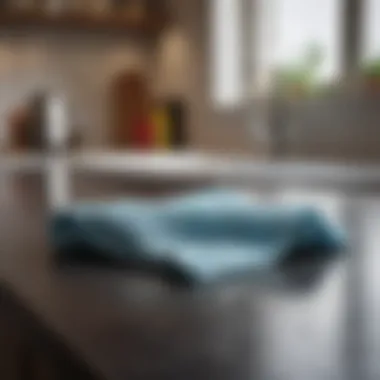Deep Cleaning an Apartment: A Comprehensive Guide


Intro
Deep cleaning an apartment is more than just a surface-level tidying up. It is an intricate process that involves tackling often overlooked areas of one’s living space. This guide will elucidate essential techniques, necessary materials, and a clear, structured approach to achieve a deep-cleaned apartment. Understanding the significance of deep cleaning not only enhances the aesthetic appeal but also contributes to a healthier indoor environment.
As urban dwellers, our apartments serve not just as shelter but as sanctuaries. Thus, the cleanliness of these spaces directly impacts our mental and physical well-being. This article will explore key areas to focus on during the cleaning process, highlight common challenges that arise, and provide effective strategies to overcome these hurdles.
Home Features
An apartment's design plays a critical role in determining cleaning strategies. Recognizing architectural features helps in devising specific cleaning techniques.
Architectural Marvels
Many apartments boast unique constructions, such as high ceilings or open floor plans. These features can impact how dust and dirt accumulate. For instance, in homes with intricate moldings, it is crucial to use the right tools to avoid damaging these elements while cleaning.
Unique Design Elements
The presence of unique design elements such as vaulted ceilings, skylights, or oversized windows can enhance the beauty of an apartment but can also pose cleaning challenges. Skylights, while brightening a room, often collect dust quickly. A microfiber cloth on a long extension pole can be essential here to maintain cleanliness without compromising the structure.
Interior Design Inspirations
Examining the interior design can provide insights into practical cleaning solutions that align with stylistic choices.
Color Palettes and Themes
The color palette of a room can influence how apparent dirt and wear are. Lighter colors may highlight dust more readily, necessitating a more frequent cleaning regime. Understanding the implications of color selection can help in planning a maintenance schedule post deep-cleaning.
Furniture Arrangement Tips
How furniture is arranged affects cleaning accessibility. For instance, furniture can block access to corners and under-surface areas. A thoughtful arrangement not only enhances the flow of a space but also makes future cleaning more manageable. Regular assessment and re-arrangement can lead to a more practical cleaning routine.
"A clean environment is crucial for mental well-being and promotes productivity at home."
This comprehensive exploration aims to equip you with knowledge and tips to tackle deep cleaning effectively, ensuring your apartment remains a comfortable and inviting place to live.
Understanding Deep Cleaning
Deep cleaning an apartment is not just a seasonal ritual, it is a fundamental practice for maintaining a healthy living environment. This process goes beyond the routine tasks many people associate with cleaning. Understanding the nuances of deep cleaning is essential for anyone who desires a pristine and well-organized space. This section articulates the importance of this topic and delves into its specific elements.
Definition of Deep Cleaning
Deep cleaning refers to a thorough cleaning process that targets hard-to-reach surfaces and areas that are often neglected during regular cleaning. It involves detailed work that includes scrubbing, sanitizing, and organizing spaces that can accumulate dirt and clutter over time. Unlike the typical daily or weekly cleaning tasks, deep cleaning involves more intensive efforts that ensure every corner of the apartment is addressed. This includes cleaning behind appliances, wiping down baseboards, and dusting high places that usually go unnoticed.
Difference Between Regular Cleaning and Deep Cleaning
The contrast between regular cleaning and deep cleaning is striking. Regular cleaning includes surface-level tasks, such as dusting, vacuuming, and mopping the floors. These tasks help maintain a certain level of cleanliness but often overlook the deeper grime that can build up in hidden places. On the other hand, deep cleaning focuses on a detailed approach that targets specific areas needing attention.
For example, deep cleaning will involve:
- Inside appliances: Cleaning the inside of the refrigerator, oven, or microwave.
- Floor care: Moving furniture to clean underneath and using specialized products to treat different floor types.
- Upholstery cleaning: This may include shampooing carpets and cleaning cushions.
Understanding this difference is crucial when setting goals for cleaning your living space efficiently and effectively.
Benefits of Deep Cleaning
Deep cleaning comes with numerous benefits that significantly enhance the living quality within an apartment. Firstly, it contributes to improved health. Dust, mold, and allergens tend to accumulate in neglected areas, leading to respiratory issues. By undertaking deep cleaning, residents can minimize these health hazards.
Additionally, deep cleaning has aesthetic benefits. A deep clean helps restore the shine and vibrancy of various surfaces, making the apartment more inviting. Moreover, it can enhance the efficiency of the apartment. Often, appliances function better when maintained properly. This can prolong the life of items like washing machines or dishwashers, reducing long-term costs.
Moreover, the psychological effects should not be overlooked. A clean, organized space can lead to reduced stress levels and increased productivity. Knowing that every corner of your home is clean allows for a greater sense of peace and contentment in daily living.
"A clean home is not just about looks; it is about creating a healthier environment for yourself and your loved ones."
In summation, grasping the concept of deep cleaning, its definition, its distinctiveness from regular cleaning, and its broad array of benefits, paves the way for a more systematic and rewarding cleaning approach. Engaging deeply with these elements transforms routine cleaning into a comprehensive practice that enhances living conditions.
Preparation for Deep Cleaning


Preparation is an essential stage in the deep cleaning process. Understandably, one might think about cleaning as a straightforward task. However, without adequate preparation, you may encounter inefficiencies, missed spots, or even burnout. Proper preparation ensures that you approach the task systematically, maximizing the effectiveness of your efforts and minimizing frustration.
Assessing the Apartment's Cleaning Needs
Before embarking on deep cleaning, it is crucial to assess the specific cleaning needs of your apartment. This should involve a thorough inspection of every room. Look for areas that have accumulated dust, grime, or clutter. Often, places like under furniture, behind appliances, and inside cabinets require attention. Taking note of these areas helps create a targeted cleaning plan, ensuring that no section is overlooked. Consider using a checklist to document these cleaning needs. This practice not only helps maintain focus but can also provide a sense of accomplishment as you check off completed tasks.
Creating a Cleaning Schedule
After identifying cleaning requirements, the next step is to create a structured cleaning schedule. Deep cleaning can be time-consuming, and breaking the task down into manageable parts prevents overwhelming feelings. You may want to designate specific days for each room or split tasks across days to balance the workload. Include realistic time frames for each task, as this can provide clarity on how to allocate your time efficiently. Setting aside dedicated sessions reduces procrastination and enhances productivity, leading to a more satisfying cleaning experience.
Gathering Essential Cleaning Supplies
An often overlooked aspect of preparing for deep cleaning is gathering the appropriate supplies. Ensure you have all essential cleaning materials at hand before beginning your work. Common supplies include:
- Multi-surface cleaners
- Disinfectants
- Brooms and vacuums
- Microfiber cloths
- Brushes for detailed areas
- Trash bags for decluttering
Having these tools ready allows for a seamless workflow. As you gather supplies, be mindful to choose products that align with your personal preferences and safety considerations, especially if there are allergies or sensitivities in your household.
Identifying Key Areas for Focus
In deep cleaning, certain areas demand more attention than others due to their frequency of use or tendency to gather dirt. Some key focus areas include:
- Living Room: Look under furniture and behind electronics.
- Kitchen: Concentrate on appliances, counters, and sinks.
- Bathroom: Pay special attention to fixtures and tiles where grime collects.
- Bedrooms: Ensure closets are sorted and dust-free.
By prioritizing these areas, you can tackle the most pressing cleaning issues first, creating a more effective deep cleaning strategy. Addressing high-traffic or heavily used areas enhances the overall cleanliness and comfort of your apartment.
Proper preparation sets the foundation for a successful deep clean, helping you achieve a thorough and satisfying result.
By emphasizing these aspects of preparation, you ensure that your deep cleaning endeavor is not just effective but also less burdensome. The structured approach leads to a cleaner, healthier, and more pleasant living environment, aligning perfectly with the goal of comprehensive deep cleaning.
Room-by-Room Deep Cleaning Strategy
A room-by-room deep cleaning strategy enhances the effectiveness of cleaning an apartment. This method allows for focused attention on each area, ensuring thoroughness and preventing the feeling of being overwhelmed. By dividing the space into manageable sections, one can systematically address all cleaning tasks without distraction.
Moreover, this approach helps identify specific needs for each room, prioritizing areas that accumulate dirt and dust. It promotes a sense of accomplishment as each room becomes clean and organized, contributing to an overall healthier living environment.
Cleaning the Living Room
Decluttering and Organizing
Decluttering is essential for maintaining a clean living room. It allows space to breathe and lessens the stress of a crowded environment. This process involves sorting items into categories of keep, donate, or discard. By fully organizing belongings, the living room becomes more functional and visually appealing, which is critical for creating a welcoming atmosphere.
Changing the arrangement of furniture can also refresh the space and improve its utility. Decluttering enhances ease of cleaning and contributes to reducing allergens.
Vacuuming and Dusting
Vacuuming and dusting play an integral role in cleaning the living room. Regular vacuuming captures dirt, dust, and debris that settles on floors and carpets. It also helps maintain the life of carpets and upholstery, making it a necessary aspect of deep cleaning. Additionally, dusting surfaces reduces allergens and can make the environment healthier.
Investing time to vacuum corners, edges of carpets, and behind furniture is crucial. Dust buildup can often be unnoticed, and targeting these areas can result in significant improvements in cleanliness.
Cleaning Upholstery and Carpets
Cleaning upholstery and carpets is vital for removing stains and odors. They often trap dirt and allergens, which can affect air quality. Depending on the fabric type, using specific cleaners can help in maintaining their appearance and texture.
Fabric protection treatments may also be beneficial after cleaning to guard against future stains. Regular maintenance not only preserves their quality but also enhances the overall aesthetic of the living room.
Deep Cleaning the Kitchen
Appliance Cleaning
Appliance cleaning is an important aspect as kitchen appliances are often the hardest working elements in a home. This task entails cleaning the refrigerator, microwave, and stove thoroughly. Many appliances can hide grime and spills, so disassembling parts when possible improves cleanliness.
A clean appliance not only functions better but also looks more appealing. This could prevent unpleasant odors and potential pests, making it a critical consideration when deep cleaning.
Surface Sanitization


Surface sanitization ensures the kitchen is free of germs and foodborne illnesses. This involves cleaning countertops, tables, and other frequently touched surfaces with disinfectant. A sanitized surface is crucial in a kitchen where food preparation occurs.
Incorporating environmentally friendly cleaning solutions can provide a safe and effective approach, aligning with modern cleaning standards that prioritize health.
Cabinet and Drawer Organization
Organizing cabinets and drawers contributes to a cleaner kitchen as well. This includes sorting items logically, cleaning shelves, and eliminating clutter from these spaces. An organized kitchen invites efficiency in meal preparation and can reduce cooking time.
Clear storage solutions can enhance visibility. As a result, you can reduce waste and ensure that essential items are easily accessible.
Tackling the Bathroom
Fixture and Surface Cleaning
Cleaning fixtures and surfaces is vital for maintaining hygiene in the bathroom. This entails scrubbing sinks, toilets, and tubs regularly. A sparkling bathroom enhances the overall satisfaction of the home.
Using specific bathroom cleaners can help eliminate soap scum and stains effectively. Additionally, this practice improves water flow and can prolong the lifespan of fixtures, making it a wise choice.
Mold and Mildew Prevention
Preventing mold and mildew is significant in bathrooms due to their moisture levels. This includes regularly checking for leaks, using exhaust fans, and employing mold-repellent products. Preventive measures may require less extensive cleaning in the long run, safeguarding air quality and health.
Organizing Bathroom Supplies
Organizing bathroom supplies systematically assists in keeping items easily accessible. Categorizing toiletries by type or purpose can improve efficiency. Not only does this create a visually appealing space, but it also helps in tracking supplies, reducing the chance of running out unexpectedly.
Cleaning Bedrooms
Bedding and Linens
Bedding and linens require special attention during deep cleaning. Regularly washing sheets and pillowcases is imperative to remove skin cells, dust mites, and other allergens. Fresh bedding contributes to better sleep quality and overall comfort in the bedroom.
Adding mattress and pillow protectors can also assist in maintaining their cleanliness and extend their lifespan.
Closet Organization
Closet organization is a fundamental step. Clearing out unnecessary clothing and ensuring that items are stored properly can optimize storage space. An organized closet means quicker outfit selection and a more enjoyable dressing experience.
This task can also encourage more mindful shopping habits, contributing to a cleaner home.
Surface Dusting
Dust accumulates quickly in bedrooms. Consistent surface dusting prevents buildup on furniture and electronics. This practice is essential for maintaining a clean atmosphere. Using microfiber cloths can trap dust effectively, ensuring thorough cleaning.
Addressing the Hallways and Entrances
Floor Cleaning
Cleaning floors in hallways and entrances is often overlooked but essential. High foot traffic areas accumulate dirt, which can spread to other rooms. Regular mopping and vacuuming can help maintain cleanliness and hygiene.
Using appropriate cleaning products suited for various flooring types ensures effectiveness without damage.
Wall and Baseboard Maintenance
Regular wall and baseboard maintenance helps prevent scuffs and grime buildup. Light cleaning can maintain appearances while occasional deep cleaning ensures a well-kept appearance. Keeping these surfaces clean contributes to the overall aesthetic and hygiene.
Air Quality Considerations
Reducing allergens in the air is essential in hallways and entrances. Using air purifiers and ensuring good ventilation helps maintain a healthy indoor environment. Regular cleaning of vents and filters contributes to improved air quality and comfort in the space.
Post-Cleaning Procedures
After completing a thorough deep cleaning of your apartment, the next crucial step is implementing post-cleaning procedures. These procedures are essential for ensuring that the efforts put into cleaning are not only recognized but also sustained over time. Proper post-cleaning practices can enhance the cleanliness of your living space and promote a healthier environment.
Evaluating Cleaning Effectiveness


Evaluating the effectiveness of your cleaning is vital. This step involves assessing whether your deep cleaning efforts have met the desired standards. You can approach this in several ways:
- Visual Inspection: Walk through each cleaned area and look for any spots that may have been overlooked, including corners, behind furniture, and under appliances.
- Surface Touch Test: Run your hands along surfaces to feel for dust, grime, or sticky residues that may need further attention.
- Feedback from Residents: If you share your apartment, ask housemates or family members if they notice any areas needing improvement. Different perspectives can highlight overlooked sections.
A critical part of evaluation is documenting findings. This can inform future cleaning sessions and highlight areas of the apartment that may require extra care or different cleaning methods.
"A thorough evaluation not only helps in identifying the success of your cleaning but also provides insight on how to enhance future cleaning routines."
Establishing a Maintenance Cleaning Routine
Once you have evaluated the cleaning effectiveness, the next task is to establish a maintenance cleaning routine. This is not only about keeping your apartment clean but also about preserving the results of the deep cleaning process. A regular maintenance routine can prevent the build-up of dirt and keep surfaces looking their best. Consider the following elements when establishing this routine:
- Daily Cleaning Tasks: Assign brief tasks that can be done daily, such as:
- Weekly Cleaning Tasks: Incorporate tasks that should happen weekly, for example:
- Monthly or Seasonal Deep Cleaning: Plan for more intensive cleaning activities that may be required on a less frequent basis, such as:
- Wiping down kitchen counters after use.
- Sweeping or vacuuming high-traffic areas.
- Quickly tidying up clutter.
- Dusting surfaces thoroughly.
- Mopping hard floors.
- Cleaning bathroom fixtures.
- Cleaning behind appliances and large furniture.
- Organizing closets, cabinets, and storage areas.
This structured approach can help maintain a clean apartment and prevent overwhelming clean-up sessions in the future. Additionally, it instills a sense of order and discipline, possibly enhancing your overall quality of life in your living space.
Common Challenges in Deep Cleaning
Deep cleaning an apartment is a formidable task that can often feel overwhelming. The Common Challenges in Deep Cleaning section aims to highlight some specific difficulties that people encounter during this process. Understanding these challenges is crucial for creating effective strategies to overcome them, ensuring that the deep cleaning endeavor is not only successful but also efficient.
Deep cleaning is not merely about tidying up; it demands considerable time, effort, and sometimes lasting dedication. Each challenge encountered can serve as a valuable lesson, providing insights that lead to wiser planning for future cleaning sessions.
Dealing with Stubborn Stains
Stains can be found in various forms across an apartment, ranging from food spills to pet accidents. Each type requires a specific approach. The first step is to identify the stain type before applying any cleaning solution. For instance, grease stains in the kitchen are especially resilient compared to water-based stains.
Cleaning agents like vinegar, baking soda, and commercial solutions can be effective, but they must be applied correctly. A technique that often proves useful is blotting rather than rubbing, as this helps to lift the stain without spreading it further. It's also important to test any cleaning product in a small, inconspicuous area to avoid potential damage. Here are some tips for effective stain removal:
- Blot stains immediately to prevent them from settling.
- Use the right cleaning agent for the stain type.
- Rinse with cold water after treating the stain.
- Consider professional services for persistent stains.
By taking a methodical approach, individuals can address stubborn stains effectively and restore surfaces to their original state.
Overcoming Time Constraints
Time is often a significant barrier to effective deep cleaning. Juggling work, family obligations, and personal commitments can make it challenging to dedicate enough time for a thorough clean. To address this, it is beneficial to break down the deep cleaning task into smaller, more manageable segments. This incremental approach allows for more focused cleaning sessions that fit into a busy schedule.
Creating a clear cleaning plan with specific goals for each session can lead to better time management. Prioritize high-traffic areas, such as the kitchen and bathroom, where dirt accumulates more quickly. Here are a few strategies to make the most of limited time:
- Set a timer for specific cleaning tasks.
- Focus on one room at a time to avoid feeling overwhelmed.
- Use multitasking approaches, such as cleaning surfaces while letting cleaners work on stubborn areas.
By organizing and being strategic about time usage, deep cleaning can be approached with greater efficiency.
Managing Allergies and Sensitivities
Cleaning can stir up dust, mold, and other allergens in the environment. Thus, handling allergies and sensitivities is a principal concern during deep cleaning tasks. For individuals with respiratory issues or sensitive skin, the types of cleaning products used become particularly important. Opting for hypoallergenic or natural cleaning products minimizes adverse reactions and maintains a healthier air quality.
Ventilation is another critical aspect. Ensure proper airflow during cleaning to dissipate any irritants. Here are some suggestions to manage allergies during cleaning:
- Wear a mask while cleaning to reduce inhalation of dust.
- Use a vacuum cleaner fitted with a HEPA filter.
- Keep windows open to improve airflow.
Being mindful of health concerns not only enhances the cleaning experience but also ensures that your home becomes a healthier living space post-cleaning.
Epilogue
The importance of concluding remarks in this article cannot be overstated. A thorough deep cleaning of an apartment is not just a task; it is an opportunity to enhance living standards and foster a healthy environment. In this guide, we have navigated through various aspects of deep cleaning, focusing on effective techniques, preparation steps, and intricate strategies suited for each room.
From understanding the nuances of deep cleaning compared to regular cleaning to identifying the specialized supplies required, readers have gained insight into a systematic approach. Notably, the discussion on post-cleaning maintenance routines reinforces the continuous nature of cleanliness. Establishing such routines ensures that the intense effort put into deep cleaning does not go to waste, keeping the living space pristine over time.
Benefits of Deep Cleaning:
- Healthier Environment: Regular deep cleaning helps eliminate allergens, dust, and bacteria, contributing to better indoor air quality.
- Aesthetically Pleasing Space: A clean apartment enhances its overall appearance, improving the mood and well-being of its residents.
- Increased Lifespan of Items: Proper cleaning prolongs the life of furniture and appliances, protecting your investment.
As we conclude, it is essential to recognize the challenges that individuals may face during the cleaning process. Stubborn stains, time constraints, and managing allergies are common issues, but they can be mitigated with careful planning and the right strategies.
Collectively, the knowledge shared in this article aims to equip readers with a robust framework for maintaining a clean and inviting apartment. By integrating the techniques and practices discussed, readers can achieve a living space that not only reflects personal style but also promotes health and serenity.
In the end, transforming one’s living environment through deep cleaning allows for a renewed sense of control and satisfaction within their home. It is more than just cleaning; it is about creating a space where life can flourish.



